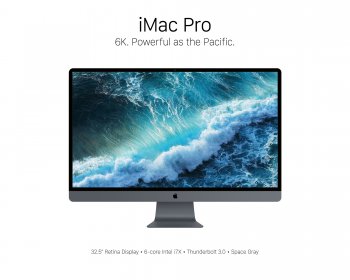Whatever.
It's the specs and the upgradability that matter to 'pros', not whether the bezel is 1 inch or a half inch. After a couple of weeks, the new 'look' of the computer, even if it was interesting to you at first, is irrelevant to 99% of users, it's how it works/performs.
To a certain extent. But we know Apple cares about this. They always sweat the details of the design. For instance, when I was making this, I used the web inspector on their site and the iMac text is set -.024em letter-spacing. I'm a web designer known for being particular about things, and even for me that's a pretty freaking specific and seemingly insignificant change. Anyway, current trend is towards smaller bezels, and I think if they make a bigger iMac, it makes sense to slim the bezels.
Nice work OP!
Depending on the price I'd certainly buy one

--
If that's the case why not just build yourself an ATX PC (or buy one from a reputable vendor if you need truly pro level support/quick turnaround which even Apple doesn't offer) and be done with it?
Aesthetics may not matter to you, but I guarantee you they matter to a large portion of Apple's customer base, and yes that includes a lot of the people who buy "pro" machines (whether you'd classify them as real "pros" or not).
Thanks! I was going really fast in PS, so things probably aren't perfectly square and the space gray look could be better. As for your comments towards the other poster, I agree that many pros care to a certain extent because we're also designers and artists and appreciate it. But like I said, only to a certain extent. They obviously took the Mac Pro a bit too far. The function needs to be put first and then develop a beautiful form around that and experiment with different designs and materials until the two fall into harmony.
i think that's too big tbh.
get the specs you want when you buy it.. then you don't have to upgrade it.
Yeah, it may be a bit large, but there are three reasons for this. First of all, Apple typically likes to share display PPI between devices as much as possible. Increasing to 32.5" keeps the same PPI at 6k. Second of all, a larger enclosure means more internal room and thermal heat dissipation for higher end GPUs and the potential use for Intel's upcoming X-series chips that have more cores than the current iMacs do. Lastly, it has been a long time since Apple increased the size of their displays. Many newer 4K and 5K displays on the market are around this size. Furthermore, many people thought the 27" iMac was way too huge when it first came out, and now we're used to it and it seems more normal. There is certainly an upper limit to what you want to use as a day to day monitor for display size because you have to move your neck around too much. And while we're probably getting close, I doubt we're there yet. They might also just call it 32" or 33" depending on exactly what 6K resolution they go with because, for example, their 4K resolution is larger than the standard. But there is precedence with the 21.5" model having an odd decimal, so who knows.
I think if Apple were to go ultra wide (21:9 aspect ratio) it'd be juuuuuuuussssssstttt right (for me)

That's actually not a bad idea either and I'd be on board for something like that. It could cut down on weight which might be a small factor with an aluminum and glass machine of this size. I'm really big into multitasking and it would be great to have even wider windows or maybe even three up windows side by side without much compromise. I also wonder if they would ever go with a curved display? Personally I think their gimmicky as every one I've seen in a person's house is incredibly difficult to watch because part of the TV curves away from you and the reflections are awful. The reflections could be awful in this case too depending on how anti-reflective it is, but when you're sitting in front of a display at close distance, having it be curved can be a better experience as every point on the display would be a more equal distance from your eyes. And as for reflections, many pros already have dimly lit workspaces with backlighting to prevent reflections. But I guess it depends on your work.


